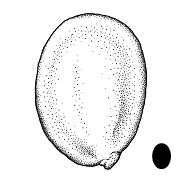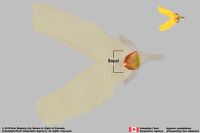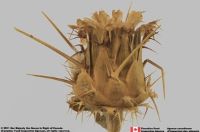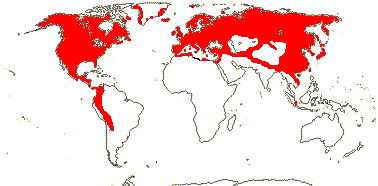Family Name: Betulaceae Gray, nom. cons.
Synonym(s): Carpinaceae Vest; Corylaceae Mirb., nom. cons.
Common Name(s): birch family
*Number of genera/species: 6/167
List of genera records in GRIN-Global
Fruit a nutletnutlet:
˜achene
or samarasamara:
a winged, indehiscent, dry fruit containing a single (rarely two) seed(s) (Betula, Alnus), 1.5–20 mm, globoseglobose:
(Betula, Alnus), 1.5–20 mm, globoseglobose:
3D shape—more or less spherical to ellipticelliptic:
to ellipticelliptic:
2D shape—oval, oblong-like with the 2 ends narrowing and more or less alike
 (nutletsnutlet:
(nutletsnutlet:
˜achene
only globoseglobose:
3D shape—more or less spherical or deltoid), tereteterete:
or deltoid), tereteterete:
approximately circular in cross section; width and thickness approximately equal
 or compressedcompressed:
or compressedcompressed:
flattened; in grasses, used to denote compression (not necessarily flattened) either laterally or dorsiventrally
samarasamara:
a winged, indehiscent, dry fruit containing a single (rarely two) seed(s) ) nutletnutlet:
) nutletnutlet:
˜achene
in Ostrya spp.) in transection, sometimes sepalssepal:
a member of the outer envelope of a flower (calyx) and stylesstyle:
and stylesstyle:
in a flower, the narrow and elongated part of the pistil between the stigma and the ovary; sometimes persisting in fruit persistent at apexapex:
persistent at apexapex:
the point farthest from the point of attachment, or the "tip" of an organ (Carpinus, Ostrya), with one seed. Carpinus, Corylus, Ostrya, and Ostryopsis fruits subtended or nearly enclosed in 2 or 3 bracts. Bracts foliaceous, lobed, laciniate, or bladderlike, sometimes pubescentpubescent:
(Carpinus, Ostrya), with one seed. Carpinus, Corylus, Ostrya, and Ostryopsis fruits subtended or nearly enclosed in 2 or 3 bracts. Bracts foliaceous, lobed, laciniate, or bladderlike, sometimes pubescentpubescent:
surface relief—bearing hairs
, hairs with or without glands. In Corylus, bracts may be connate apically and extended forming tubular involucreinvolucre:
in the grasses, a whorl or cluster of bracts or bristles subtending a floret or spikelet surrounding nutnut:
surrounding nutnut:
a fairly large, indehiscent, dry fruit with a thick and bony wall surrounding a single seed, derived from a single, simple or compound ovary . SamarasSamara:
. SamarasSamara:
a winged, indehiscent, dry fruit containing a single (rarely two) seed(s) with two laterallateral:
with two laterallateral:
(of embryo) embryo lies along the side of the seed, generally towards one end; of, at, or from the side; in grasses, can refer to the sides adjacent to the dorsal and ventral sides
wings, sometimes reduced to ridges. Wings membranousmembranous:
texture—extremely thin, pliable, and fairly tough
, paperypapery:
texture—papyraceous, chartaceous; very thin, pliable, and readily torn; like paper
, or leatheryleathery:
texture—moderately thick, tough, and very pliable
. Pericarppericarp:
fruit wall or fruit coat
brown, red-brown, olive or yellow, thin to thick walled, membranousmembranous:
texture—extremely thin, pliable, and fairly tough
, woodywoody:
texture—consisting mainly of indurate lignified tissues, characteristic of or resembling wood
, or bonybony:
very hard and rather brittle, like bone
. Fruits glabrousglabrous:
without hairs
or pubescentpubescent:
surface relief—bearing hairs
. In Carpinus, fruits often with resinous brown, orange, or yellow glands. NutletsNutlet:
˜achene
usually longitudinally ribbedribbed:
surface relief—wide, prominent, linear ridges that are generally rounded and longitudinally situated on the surface .
.
Seeds same shape as fruit, tereteterete:
approximately circular in cross section; width and thickness approximately equal
 or flattened in transection, 1.5–20 mm. Seed brown, dulldull:
or flattened in transection, 1.5–20 mm. Seed brown, dulldull:
reflecting only a low proportion of incident light, with no apparent sheen or shinyshiny:
or shinyshiny:
uniformly reflecting a high proportion of incident light at all angles , reticulatereticulate:
, reticulatereticulate:
surface relief—netted, raised walls or concave grooves forming a net-like surface pattern with flat, concave, or convex interspaces or ribbedribbed:
or ribbedribbed:
surface relief—wide, prominent, linear ridges that are generally rounded and longitudinally situated on the surface . Seed coat thin, membranousmembranous:
. Seed coat thin, membranousmembranous:
texture—extremely thin, pliable, and fairly tough
.
Embryo well developed, nearly filling or fully filling seed cavity, axileaxile:
on or of the axis
and centric, foliatefoliate:
appearing leaf-like
, straight, with investinginvesting:
(of embryo) embryo is nearly or completely filling seed coat, straight, and axile and centric with spatulate cotyledons and covering the stalk for at least half its length; (of cotyledons) cotyledons spatulate and covering the stalk for at least half its length
or spatulatespatulate:
2D shape—like a spatula; rounded at the apex, with base long and tapered; (of embryo) embryo is straight and axile and centric with the cotyledons expanded to form the shape of a spatula or spoon; (of cotyledons) cotyledons expanded and wider than the stalk but not invested into the stalk , thick cotyledons.
, thick cotyledons.
Endosperm scanty.
| Fruit | |
| Type | nutletnutlet: ˜achene , samarasamara: a winged, indehiscent, dry fruit containing a single (rarely two) seed(s)  |
| Size range | 1.5–20 mm long |
| Shape(s) | nutlets–globose, deltoid; samara–obovate, ovateovate: 2D shape—egg-shaped in outline, widest point is towards one end of the organ, the other end tapers gradually, attachment at or near the broad end (compare obovate, ovoid)  , oblongoblong: , oblongoblong:2D shape—much longer than broad with nearly parallel sides, corners are rounded  , suborbicular, ellipticelliptic: , suborbicular, ellipticelliptic:2D shape—oval, oblong-like with the 2 ends narrowing and more or less alike  |
| Texture | membranousmembranous: texture—extremely thin, pliable, and fairly tough , woodywoody: texture—consisting mainly of indurate lignified tissues, characteristic of or resembling wood , bonybony: very hard and rather brittle, like bone |
| Surface relief | smooth, longitudinally ribbedribbed: surface relief—wide, prominent, linear ridges that are generally rounded and longitudinally situated on the surface  , glabrousglabrous: , glabrousglabrous:without hairs , pubescentpubescent: surface relief—bearing hairs |
| Color(s) | brown, red-brown, olive, yellow |
| Unique features | Small one-seeded nutletsnutlet: ˜achene enclosed or subtended by bracts. Or laterallateral: (of embryo) embryo lies along the side of the seed, generally towards one end; of, at, or from the side; in grasses, can refer to the sides adjacent to the dorsal and ventral sides winged samarassamara: a winged, indehiscent, dry fruit containing a single (rarely two) seed(s)  . . |
| Seed | |
| Size range | 1.5–20 mm long |
| Shape(s) | same as fruit |
| Surface relief | reticulatereticulate: surface relief—netted, raised walls or concave grooves forming a net-like surface pattern with flat, concave, or convex interspaces  , ribbedribbed: , ribbedribbed:surface relief—wide, prominent, linear ridges that are generally rounded and longitudinally situated on the surface  |
| Color(s) | brown |
| Unique features | Brown seeds with membranousmembranous: texture—extremely thin, pliable, and fairly tough seed coats and embryo nearly to fully filling seed coast. |
| Other | |
| Embryo | well developed, nearly filling or fully filling seed cavity, axileaxile: on or of the axis and centric, foliatefoliate: appearing leaf-like , straight, with investinginvesting: (of embryo) embryo is nearly or completely filling seed coat, straight, and axile and centric with spatulate cotyledons and covering the stalk for at least half its length; (of cotyledons) cotyledons spatulate and covering the stalk for at least half its length or spatulatespatulate: 2D shape—like a spatula; rounded at the apex, with base long and tapered; (of embryo) embryo is straight and axile and centric with the cotyledons expanded to form the shape of a spatula or spoon; (of cotyledons) cotyledons expanded and wider than the stalk but not invested into the stalk  , thick cotyledons , thick cotyledons |
| Nutritive tissue | endosperm trace |
North temperate regions and tropical mountains of South America.

Distribution map courtesy of Angiosperm Phylogeny Website.
Brasher 2001Brasher 2001:
Brasher JW. 2001. Betulaceae Birch Family. Journal of the Arizona-Nevada Academy of Science 33(1): 1–8. http://www.jstor.org/stable/40022245; Flora of North America Editorial Committee 1993+Flora of North America Editorial Committee 1993+:
Flora of North America Editorial Committee, eds. 1993+. Flora of North America North of Mexico [Online]. 22+ vols. Flora of North America Association, New York and Oxford. Accessed January-March 2024. URL: http://beta.floranorthamerica.org.; Kirkbride et al. 2006Kirkbride et al. 2006:
Kirkbride JH, Jr, Gunn CR, and Dallwitz MJ. 2006. Family guide for fruits and seeds, vers. 1.0. Accessed September 2020-January 2022. URL: https://nt.ars-grin.gov/seedsfruits/keys/frsdfam/index.cfm .; Kubitzki et al. 1990+Kubitzki et al. 1990+:
Kubitzki K et al., eds. 1990+. The families and genera of vascular plants. 7+ vols. Berlin etc.; Nee 1981Nee 1981:
Nee M. 1981. Betulaceae. Flora de Veracruz. Fasciculo 20. El Instituto National de Investigaciones sobre Recursos Bioticos, Xalapa, Veracruz, Mexico.; Noxious Weed Regulations 2020Noxious Weed Regulations 2020:
Noxious Weed Regulations. 2020. 7 C.F.R. sect; 360.100-360.600.; Takhtajan 2009Takhtajan 2009:
Takhtajan A. 2009. Flowering plants: Second edition. Springer Nature, Switzerland. 871 pp.; Tropicos.org 2021+Tropicos.org 2021+:
Tropicos.org. 2021+. Pakistan Plant Database. Missouri Botanical Garden. Accessed January 2021–April 2024. http://legacy.tropicos.org/Project/Pakistan, Tutin et al. 1964–1980Tutin et al. 1964–1980:
Tutin TG, Burges NA, Chater AO, Edmondson JR, Heywood VH, Moore DM, Valentine DH, Walters SM, and Webb DA (eds.) 1964–1980. Flora Europaea. 5 vols. Cambridge University Press, Cambridge UK. 2,524 pp.; Zhengyi et al. 2004+Zhengyi et al. 2004+:
Zhengyi W, Raven PH, and Deyuan H. 2004+. Flora of China [online]. 25 vols. Science Press, Beijing China & Missouri Botanical Garden, St. Louis USA. Accessed January–March 2024. http://flora.huh.harvard.edu/china/
*The number of genera and species is based on Christenhusz and Byng 2016Christenhusz and Byng 2016:
Christenhusz MJM and Byng JW. 2016. The number of known plant species in the world and its annual increase. Phytotaxa 261 (3): 201-217. https://doi.org/10.11646/phytotaxa.261.3.1, which may differ from the number of genera in GRIN-Global.